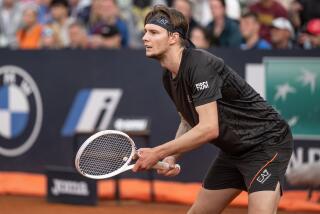Putting a Charge in It
- Share via
Some advice for tennis fans at Indian Wells for the start of the men’s tournament in the Pacific Life Open today: Get a draw sheet, find the name Jonas Bjorkman and head out to the back courts.
That’s where the Swedish journeyman will be, where he has been for most of his 16-year career, other than in 1997, when he stunned everybody by going 71-26 and finished the season ranked fourth in the world.
He is no longer young, no longer a frequent sighting on the big courts with the luxury suites and the people sipping chardonnay in their designer Filas.
He is also no less entertaining and no less worth watching. At 33 -- he will turn 34 on March 23 -- he is the third-oldest regular participant on the men’s tour, after Andre Agassi, one month from his 36th birthday, and Wayne Arthurs, a week from his 35th.
As much as his age, Bjorkman’s style of play makes him a tennis dinosaur.
Bjorkman follows his serve to the net, a technique last seen commonly in the era of Jack Kramer, wooden rackets and long pants. Now, in men’s tennis, players go to the net only when struck by diving birds that leave them dazed and disoriented.
It isn’t totally their fault. They are now asked to play with balls that weigh as much as baseballs, fluffed up like a Don King hairdo and squished into slow courts of sandy, gooey compositions. A game not long ago played mostly on slick grass has become the Pro Swamplands Tour.
Among the men who play regularly, a few renegades still try to attack behind the serve -- Taylor Dent, Tim Henman, Ivo Karlovic, Mario Ancic and Arthurs, as well as Bjorkman’s current doubles partner, Max Mirnyi.
Bjorkman has never quit trying to serve and volley. He has reasons, and a sense of humor about it.
“I’d look pretty stupid if I stayed back at the baseline after hitting the kind of serve I do,” he says.
He is also serious about what the game has become.
“It is sad to see the game go this way,” he said. “When I’m done, I won’t watch two guys stay back at the baseline and slug it out.”
The true artists of the last serve-and-volley era, Stefan Edberg, John McEnroe, Pete Sampras, Patrick Rafter and Boris Becker, are gone.
Bjorkman has persevered at what he does because it is what he knows and what he likes. It has also meant that he has had most of his success in doubles, where you’d better know how to play at the net or you’ll lose.
Last month, the Swedish dinosaur shared one side of the net with an American dinosaur, McEnroe. The result was a stunning tournament doubles title at San Jose.
The tournament director, Bill Rapp, had been working on getting the still-proficient McEnroe, now 47, back into an ATP main draw. He identified Bjorkman, with his 44 doubles titles and eight Grand Slam doubles titles, as a worthy partner.
McEnroe said yes, the two quickly clicked, and the San Jose championship was theirs.
“He is a true legend,” Bjorkman said. “We see doubles the same way. It worked right away.”
Like all so-called doubles specialists, Bjorkman bristles a bit at the label. He has been No. 4 in the world, seen the bright lights of the big-stadium center courts, been to a U.S. Open semifinal and a Wimbledon quarterfinal.
“It is still fun,” he says. “It still feels the same when you get out on a center court. I still get the same chills as I did when I was 20. And in some ways, it is even better because now, if you are successful, it is so much bigger because the fields are so much better.
“I’ve been lucky. I haven’t had a serious injury since 1990 [a year before he had a world ranking], and here I am, still trying. I never thought I’d be playing at 34.”
He hasn’t finished a year out of the top 75 since 1993, has played in 48 of the last 49 Grand Slam tournaments, has made more than $12 million in prize money, entered last week’s Tennis Channel Open in Las Vegas at No. 64 -- he’s No. 68 now -- and has never stopped moving forward, in his goals and on his serve.
He lists among his highlights his 1-0 record against his friend and retired countryman, Edberg, winner of six Grand Slam singles titles, whom he beat in a third-round match at the U.S. Open.
“When I see him, I always remind him that I dominated him in singles,” Bjorkman says. “He, of course, reminds me of the 40 or so practice matches we played, where he won them all.”
More to Read
Go beyond the scoreboard
Get the latest on L.A.'s teams in the daily Sports Report newsletter.
You may occasionally receive promotional content from the Los Angeles Times.











